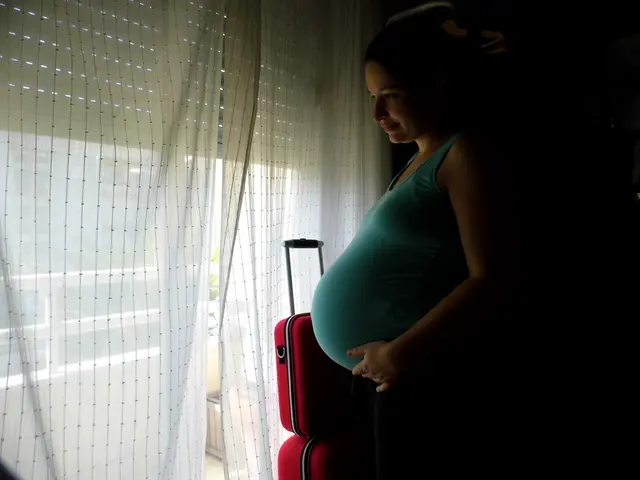Images, signs, origins, and remedies of Bruised Ribs
In a nutshell, the ribs - flexible bones that form the ribcage - protect essential organs such as the heart, lungs, and spleen. Injuries to these bones, often due to direct trauma or impact, can result in bruised or broken ribs, a common occurrence that primarily affects individuals involved in falls, sports, car accidents, or those suffering from severe coughing, especially those with osteoporosis.
Symptoms of such injuries typically include sharp or aching pain in the rib area, which worsens with deep breathing, coughing, sneezing, or movements like bending or twisting. Pain may be worse at night or when lying on the injured side, and difficulty taking deep breaths and shallow breathing are common, sometimes making coughing or sneezing painful. Swelling and tenderness over the injured ribs are also frequent signs.
Diagnosing a bruised or broken rib involves a thorough clinical examination, with imaging such as X-rays, CT scans, or ultrasounds used to confirm fractures and rule out complications like lung injury.
Effective pain management and maintaining good lung function are essential for recovery. Treatments focus on managing pain and supporting breathing, with pain control achieved through over-the-counter painkillers for mild pain, prescription analgesics or nerve blocks for severe pain, and the application of ice during the first 48 hours and heat therapy afterward to relieve pain. Deep breathing exercises, incentive spirometry, and physical therapy are recommended to avoid lung complications like pneumonia. It's crucial to avoid binding or wrapping the chest, as this can restrict breathing and increase the risk of lung issues.
Surgical intervention is rare and usually reserved for complex fractures or flail chest situations. Healing time varies, with simple bruised or broken ribs usually healing within 6 to 8 weeks, and more complex fractures taking 3 to 6 months. Healing is slower in elderly patients or those with risk factors such as smoking or poor nutrition.
In the case of children, rest, the use of cold and hot packs, pain relievers, and gentle stretching are encouraged to promote healing. If a child experiences fever, trouble breathing, abdominal pain, or dizziness or lightheadedness, contact a doctor immediately.
In summary, prompt diagnosis, effective pain management, and careful attention to lung function are crucial in the recovery from bruised and broken ribs. It's essential to seek medical advice if symptoms persist or worsen, and to take care when engaging in activities that may cause further injury.
- Multiple health conditions, such as diabetes, psoriasis, Crohn's disease, psoriatic arthritis, and depression, can sometimes predict an increased risk of accidents and falls, potentially leading to injuries like broken ribs.
- Science and health-and-wellness research suggests that regular fitness-and-exercise routines, along with proper therapies-and-treatments, may help manage and reduce the risk of conditions like type 2 diabetes, migraine, multiple sclerosis, and asthma, thereby minimizing accidental falls and the resulting rib injuries.
- COPD, a disease characterized by chronic bronchitis or emphysema, can cause severe coughing, which might potentially lead to injuries like rib fractures in individuals prone to osteoporosis.
- Arthritis, a condition that affects the joints, can cause inflammation and pain in the chest area, making it hard to distinguish between arthritis symptoms and chest pain caused by rib injuries, emphasizing the importance of a comprehensive health evaluation.
- Atopic dermatitis, a chronic skin disease, shares some symptoms with rib injuries, such as discomfort and tenderness in the affected area, although its primary manifestation is on the skin instead of the ribcage.
- Though not directly related to the ribcage, neck pain and headaches caused by migraines can be alleviated through proper fitness-and-exercise routines, massages, and other alternative therapies, thereby promoting overall health and well-being.
- AQ (Asthma Quality of Life Questionnaire) is a tool used to assess the quality of life for individuals with asthma, helping healthcare providers to tailor fitness-and-exercise regimens and other treatments to minimize complications such as asthma attacks and related potential injuries, like those affecting the ribcage.
- Fractures, in addition to being secondary complications of rib injuries, can also arise from osteoporosis, especially in the hips, spine, and wrists, making it crucial for those with this condition to prioritize a healthy diet, exercise, and appropriate therapies-and-treatments to maintain bone health and prevent such fractures.
- NSCLC (non-small cell lung cancer) is a disease that primarily affects the lungs, and its treatment may sometimes involve chest surgery, resulting in postoperative pain and restrictions in movement, which might resemble symptoms of rib injuries.
- In addition to assessing the underlying cause of high blood pressure, such as genetics, obesity, or stress, healthcare providers must also consider the possible impact of other health factors, like diabetes or depression, when formulating a treatment plan to mitigate the risks associated with conditions like stroke or heart disease, which could originate from the chest area.
- While rib injuries are often recognized by symptoms like pain, swelling, and difficulty breathing, more subtle conditions like fibromyalgia may present with similar symptoms, requiring a thorough understanding of a patient's overall health to arrive at an accurate diagnosis and treatment plan.
- To achieve overall health and well-being, it is essential to engage in regular fitness-and-exercise, embrace a balanced diet, and commit to any specified therapies-and-treatments, not only to prevent accidents and injuries but also to improve overall quality of life and reduce the risk of complications arising from various health conditions, such as diabetes, asthma, and depression.




